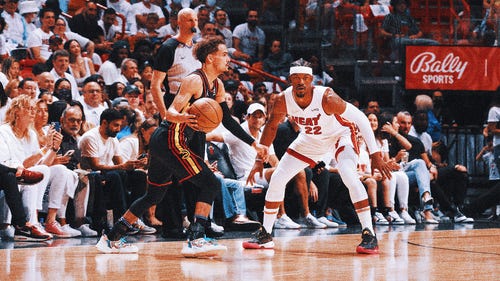
For Harrison Barnes, All Roads Lead To Ames
“You don’t belong here.” Harrison Barnes, an impossible 14-year-old, had drop-stepped his way into a basket-jolting dunk on the first day of freshman practice. That night, his mother was informed of the damage he had done. Changes were made, permissions granted, and on Day Two, Barnes was informed in no uncertain terms that a team of underclassmen was no place for him. “You don’t belong here,” Ames High basketball coach Vance Downs told him. That messaged proved to be extraordinarily true.
One of the nation’s top prospects, after all, doesn’t belong in the eighth-largest town in Iowa. The state itself had produced but a modest handful of NBA players with any staying power. Yet Barnes was the subject of a cosmic coincidence—not only in that he would buck incredible odds to make it all the way from Ames to the NBA lottery, but that he turned out to be one of two players to do so in the same high school class. As Barnes threatened to tear down the rim, a scrawny, 5'9" kid named Doug McDermott tried to find his place below it. Each proved to be an anomaly. Together, they represented an astonishing twist of chance and fate.
Consider this: When Barnes and McDermott were seniors in 2010, roughly one in every 16,000 non-collegiate residents of Ames would go on to be an NBA lottery pick. "As time goes,” Downs said, “it becomes unfathomable that that really happened at one small high school in Ames, Iowa.” And all that did—the state titles, the back-to-back undefeated seasons, and the media blitz unlike anything Ames had ever seen—began with Barnes.
Or really, it began with Shirley Barnes. Most everyone in Ames lives within a few degrees of separation from Iowa State University; those in the city who aren’t graduates are usually related to one, and even those who aren’t tend to work in or around the college in some capacity. For Barnes, that connection came through his mother, a former student. “She loved it,” according to Barnes. So much so that she stayed and worked at the school for nearly two decades.
This is how things go in Ames. “People go there, they live there, and they never leave,” Barnes said. One could make a make a comprehensive lineage using nothing but Ames High yearbooks. “Here's one family, all of them came back through and their brothers went there, and their sisters went there, and then their kids go there,” Barnes said. “When I go back, it's really like nothing has changed. People who still live there still live the same life, still do the same things. It's pretty unique.”

Smaller towns—even college towns—can have a way of seeming frozen in time. Their constancy is a part of their charm. Establishments mature into institutions. Buildings are allowed to age rather than be torn down. When Barnes returns to Ames a few times a year, he arrives there through a wormhole. Going home means visiting familiar faces, ordering up pancakes from the same breakfast spot he and his teammates would frequent after their Saturday morning practices, and falling back into the comforting rhythms of living with your mother and sister.

Little has changed in Ames, even as everything changed for Barnes. A young Harrison attended basketball camps run by Fred Hoiberg, himself an Ames legend and accidental local politician. “That was the big thing, man,” Barnes said. “Those were the cream of the crop for Iowa kids who would never get a chance to get close to the NBA.” Now Barnes runs his own camp – playing in games, answering questions, and making himself accessible to eager kids who live their NBA dreams vicariously. “That makes their year,” Downs said. Perhaps Barnes has unknowingly crossed paths with the next Iowan anomaly.
When Barnes takes to the floor of his old gym now, he does so with Mavericks coach Rick Carlisle in tow. The streets Barnes has long known well became the route for a parade held in his honor. Friends and fans who cheered him on the court instead gathered to watch him receive the key to the city. Progressing from high-school phenom to max-contract professional has a way of inverting and magnifying dynamics of all kinds.

Barnes remembers when the fervor began. “One reporter was a big deal,” he said. “If you got the Des Moines Register to come down, it was like you were really doing something. Then it went from two people to five to 10 to a high school media scrum.” That may be par for the course for a basketball powerhouse that churns out blue-chip prospects, but Ames High had to create an infrastructure around Barnes to accommodate the attention. Media availability for the never-ending stream of interviews and photo sessions was limited to a 30-minute window on Mondays to allow Barnes some small sense of normalcy. The growing ranks of big-time college coaches coming through Ames to watch Barnes play had to be sequestered at opening tip, else they’d be hounded for photos and autographs the entire game. The attention drawn to Barnes warranted the creation of a traveling detail; so many kids wanted to meet and talk with Harrison as Ames High entered and exited a gym that the school’s athletic director, one of its assistant principals, an assistant athletic director, and a rotating cast of non-basketball coaches came along to help serve as a buffer. Even sitting in the stands to watch the Ames girls’ team play became untenable for Barnes without support.
“It was different,” Barnes said. “I was just a kid from Ames.”
Gyms were packed so full that police were brought in for crowd control and people had to be turned away at the door. A star like Barnes brought an ESPN broadcast to town and the Ames High Little Cyclones to the floor of Hilton Coliseum, home of the real Cyclones. When Barnes was ready to make his college commitment, satellite trucks lined up outside the high school to alert the world. Cyclone alumni packed the gym only to hear that Barnes would continue his basketball career in Chapel Hill. The Iowa State fight song, queued up hopefully on the sound system, never played. But in a parallel universe, maybe it had. Hoiberg signed on to coach the Cyclones just a few months after Barnes had announced his choice. The timing was all wrong. “It was too late,” Barnes said. “But had he got the job earlier, I might've went there.”

The two would again pass quietly in the night in 2014 when the Warriors—Barnes’s team at the time—called Hoiberg to gauge his interest in their coaching vacancy. Hoiberg wasn’t quite ready to take the NBA leap. A year later, he would accept a job offer from the Bulls to coach a roster that included, of all people, Doug McDermott. Those three sons of Ames have a way of swirling around one another, and on Tuesday night they collide when the Bulls host the Mavericks. Neither team is quite where it had hoped it would be. Yet for Barnes, even the trials of a losing season have served as fertile developmental ground.
Barnes followed a course that put him under the microscope in college but made him a champion in the pros. It alternatingly hid him away in a limited role and featured him as a weapon against mismatches. It showcased him as one of the most situationally valuable small-ball forwards in the league: a lanky, athletic wing with the lower body strength to withstand even burly post scorers. Barnes found his way at every stop and at every level. His play created enough intrigue that the Mavericks saw fit to sign him for the maximum value allowed. There was fair reason to believe that Barnes, inconsistent and indecisive as he was in Golden State, would make for a wobbly go-to scorer. Nearly every piece of evidence from Dallas this season makes a compelling argument to the contrary—a body of work that, in total, speaks to a star who belongs.






